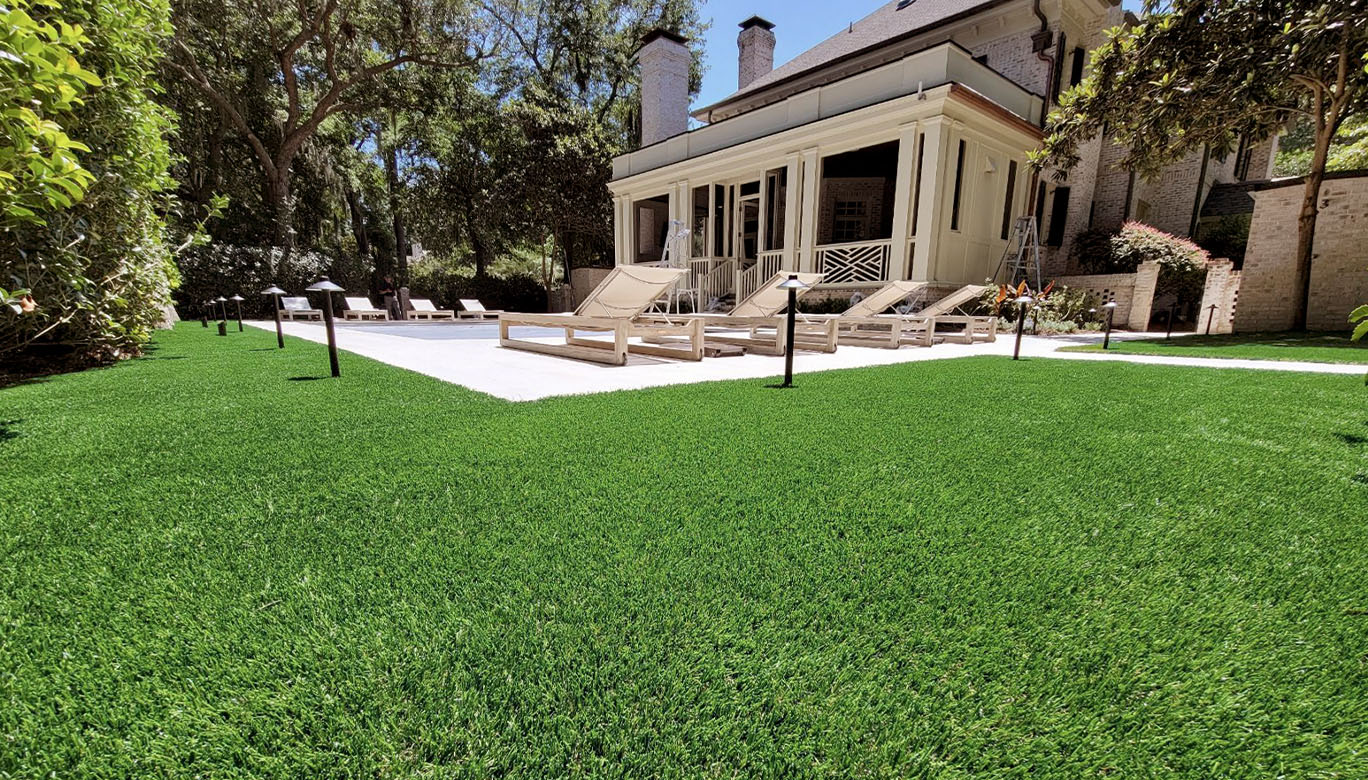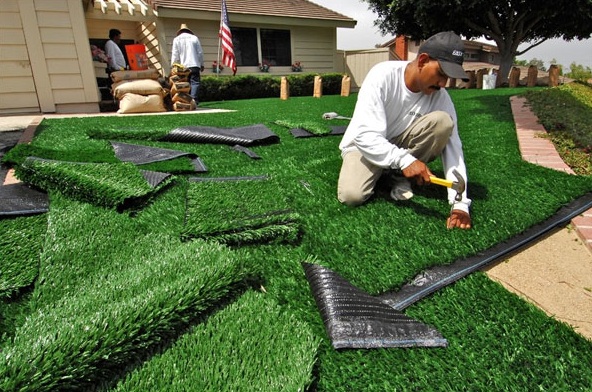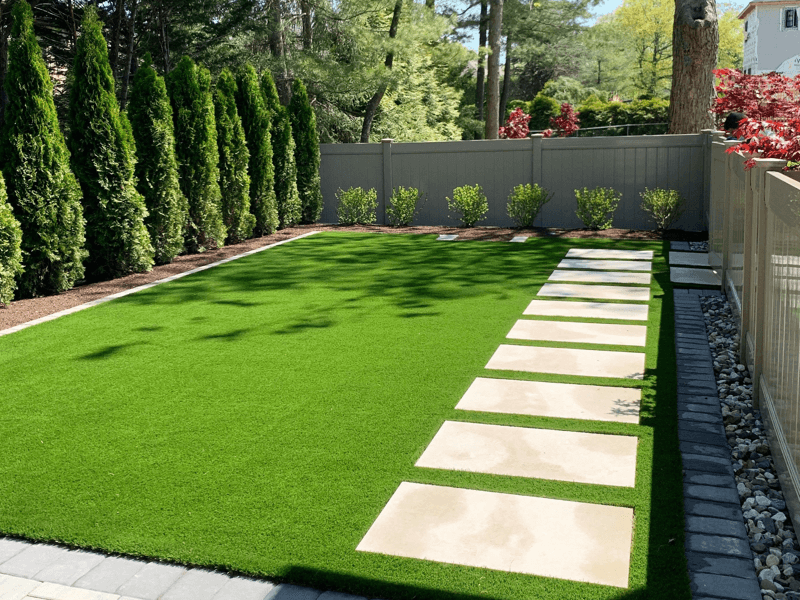Delve Into the Environmental Perks of Opting for Artificial Grass Solutions
The adoption of man-made lawn options provides an engaging opportunity to deal with pushing environmental challenges. By dramatically decreasing water use and lessening the application of dangerous chemicals, these options not just advertise lasting landscaping yet likewise secure neighborhood ecosystems. The reduced carbon footprint linked with decreased maintenance tasks contributes to an extra lasting method to land management. The ramifications of these benefits prolong beyond mere conservation initiatives, increasing questions concerning their long-lasting effect on habitat conservation and overall ecological equilibrium. Checking out these dimensions exposes an intricate interaction worth thinking about.
Water Preservation Advantages
Among the most significant advantages of synthetic grass is its capability to conserve water. Standard yard yards need considerable watering, especially in locations prone to drought or water restrictions. In contrast, man-made grass does not need watering, dramatically lowering the total demand for water sources. This function is specifically beneficial in deserts where water scarcity is a pushing issue.
By getting rid of the demand for normal watering, synthetic grass contributes to lasting landscape practices and aids minimize the ecological effect of too much water consumption. The conservation of water expands to the reduction of overflow, which can lead to soil disintegration and river contamination.
Furthermore, the installment of synthetic grass enables municipalities and home owners to allocate water sources much more effectively, focusing on vital uses such as alcohol consumption water and farming. The change in the direction of synthetic grass not only promotes accountable water use yet additionally lines up with more comprehensive ecological goals intended at protecting natural resources.
As neighborhoods significantly prioritize sustainability, the water preservation advantages of synthetic grass offer a compelling case for its fostering in industrial and property landscaping jobs.
Minimized Chemical Use
The shift to synthetic turf dramatically reduces the dependence on chemical therapies frequently utilized in all-natural turf maintenance. Standard turf management typically entails the application of herbicides, fertilizers, and pesticides to promote growth and control pests. These chemicals can pose dangers to human health and wellness, local wildlife, and the setting, adding to soil and water contamination.
On the other hand, synthetic grass eliminates the demand for these unsafe compounds. When mounted, it needs very little upkeep, mainly consisting of routine cleaning and irregular infill replenishment. This decrease in chemical use not just profits the instant environment however also contributes to broader ecological stability. By decreasing the release of synthetic compounds right into the ecosystem, artificial lawn promotes healthier soil and water systems.
Moreover, the lack of chemical runoff connected with fabricated lawn setups helps protect neighborhood waterways from contamination, sustaining aquatic life and keeping biodiversity. Phoenix turf companies. As areas increasingly prioritize lasting methods, selecting synthetic grass offers a viable remedy that aligns with environmental conservation goals. Via this shift, homeowner can delight in rich environment-friendly spaces without compromising environmental health and wellness, leading the way for a more sustainable future
Lower Carbon Footprint

Furthermore, the setup of synthetic grass can cause considerable water conservation. Natural lawns require substantial quantities of water for irrigation, which not only includes in the carbon footprint related to water removal and treatment however additionally strains regional water resources. On the other hand, synthetic grass needs very little upkeep, requiring no watering, thus significantly lowering water use and its associated power costs.
In click for more addition, the longevity of synthetic grass contributes to its decreased carbon impact. With a life-span of as much as 15 years or more, the demand for regular substitutes is reduced, resulting in much less waste and reduced power intake in production and throwing away standard grass options. On the whole, artificial grass offers a lasting option for environmentally aware landscape design.
Environment Preservation
Habitat conservation is a vital consideration in the debate over landscaping choices, specifically when comparing synthetic grass to all-natural lawn. All-natural yard yards usually call for substantial upkeep, including making use of pesticides, plant foods, and herbicides, which can adversely impact local communities. These chemicals can seep right into the soil and waterways, damaging indigenous vegetation and animals and disrupting neighborhood habitats.
On the other hand, synthetic grass offers a chance to minimize the ecological impact of landscaping. By choosing for artificial turf, house owners can reduce the disturbance of natural environments associated with conventional yard treatment practices. Artificial lawn eliminates the demand for unsafe chemicals, thereby safeguarding close-by wild animals and keeping the integrity of surrounding communities. Moreover, the installment of synthetic grass can lead to the conversion of previous turf areas into more biodiverse landscapes, such as pollinator gardens or indigenous plant locations, which can sustain regional wildlife.
Ultimately, the change to synthetic grass not just saves water and lowers maintenance efforts however likewise fosters an extra harmonious connection between human activities and the natural environment, promoting environment conservation in the process.
Long-Term Sustainability
Lasting sustainability is a crucial consider evaluating the advantages of man-made turf over conventional yard yards. One of one of the most significant advantages of synthetic grass is its toughness; it can last approximately 15-20 years with marginal maintenance, whereas natural grass requires constant reseeding and replacement. This durability decreases the requirement for continuous sources, such as water, plant foods, Get the facts and pesticides, which are vital for maintaining a healthy yard lawn.
Additionally, fabricated grass adds to a reduction in carbon emissions connected with yard care tools. Standard yards often require gas-powered lawn mowers, leaners, and blowers, every one of which contribute to air contamination. Turf installation phoenix az. On the other hand, man-made lawn gets rid of the demand for such tools, advertising a cleaner atmosphere
Furthermore, the production of synthetic grass progressively makes use of recycled products, improving its sustainability profile. As manufacturers take on environmentally friendly techniques, the ecological impact of synthetic grass remains to reduce.

Final Thought
The adoption of man-made turf services offers substantial environmental advantages, consisting of considerable water conservation, decreased dependence on hazardous chemicals, and a reduced carbon footprint. Fabricated lawn help in maintaining all-natural habitats by decreasing land disruption and advertising lasting sustainability via the usage of sturdy materials. Jointly, these factors emphasize the capacity of synthetic grass to add favorably to environmental health and offer a practical choice to conventional landscaping methods in a progressively resource-conscious globe.
In contrast, man-made turf does not require watering, substantially reducing the total need for water resources. By minimizing the launch of artificial compounds into the community, synthetic lawn advertises healthier soil and water systems.
Additionally, the installment of fabricated lawn can result in considerable water preservation. In contrast, artificial turf needs minimal maintenance, needing no watering, consequently significantly lowering water use and its linked energy expenses.
